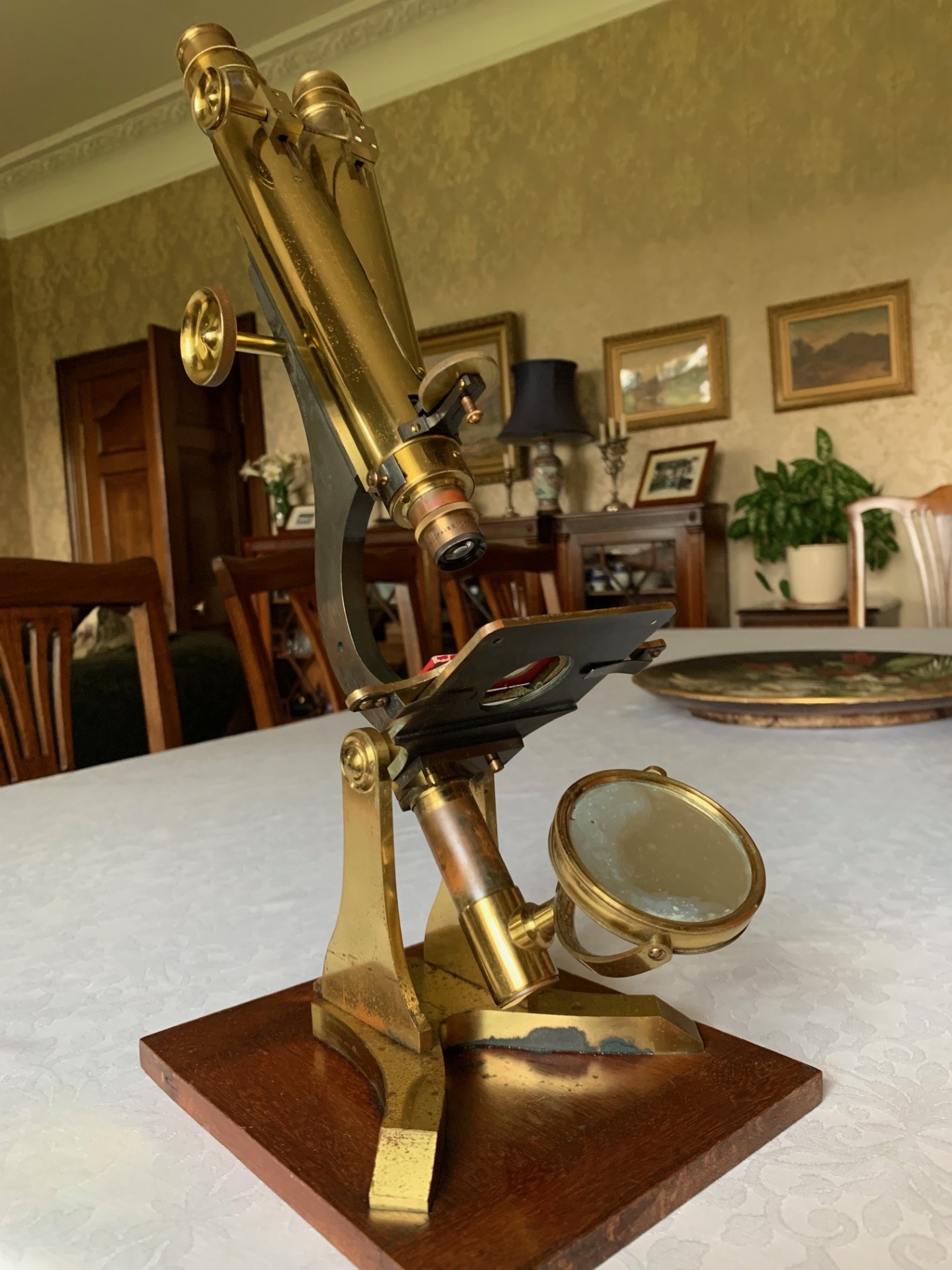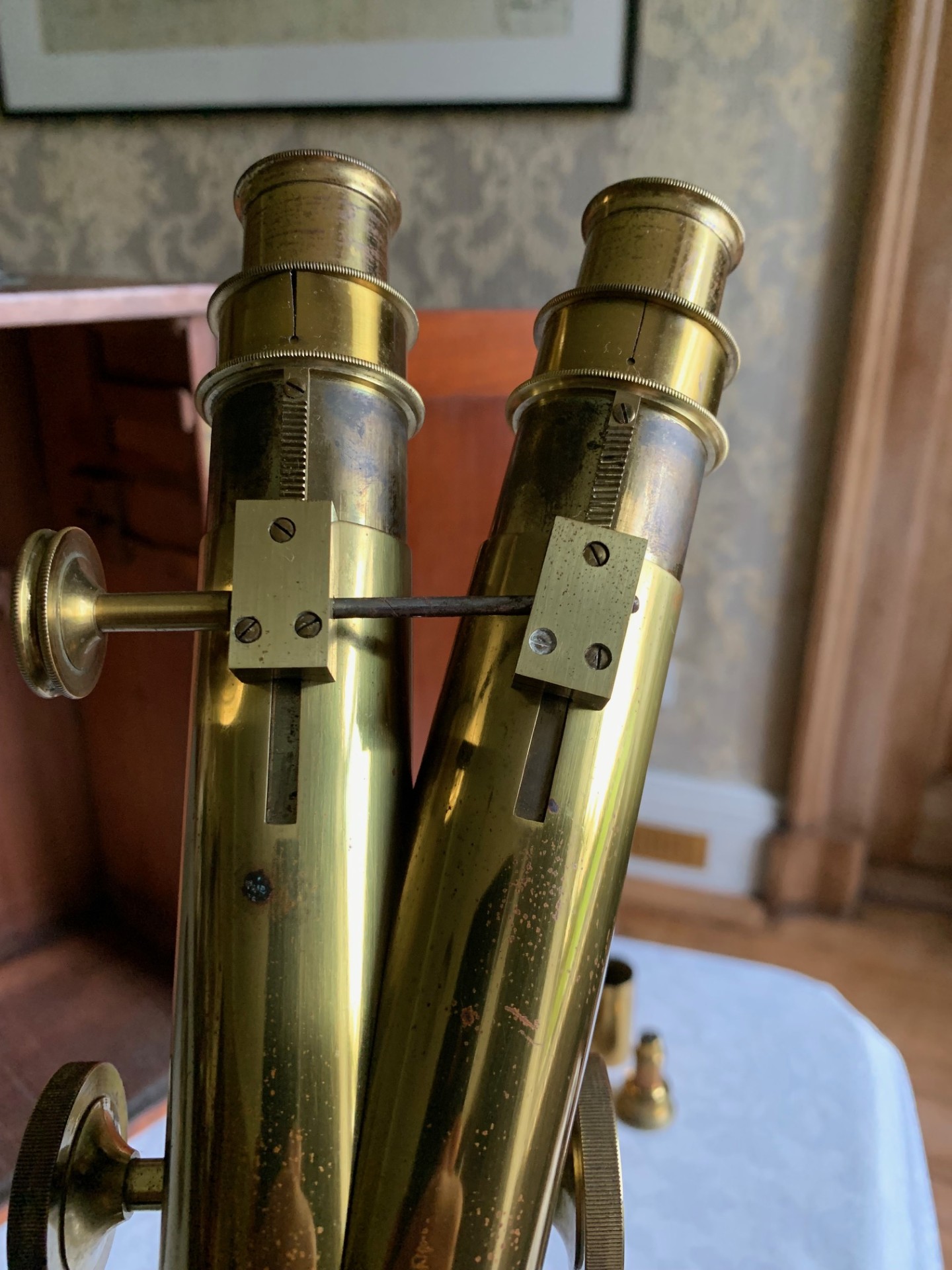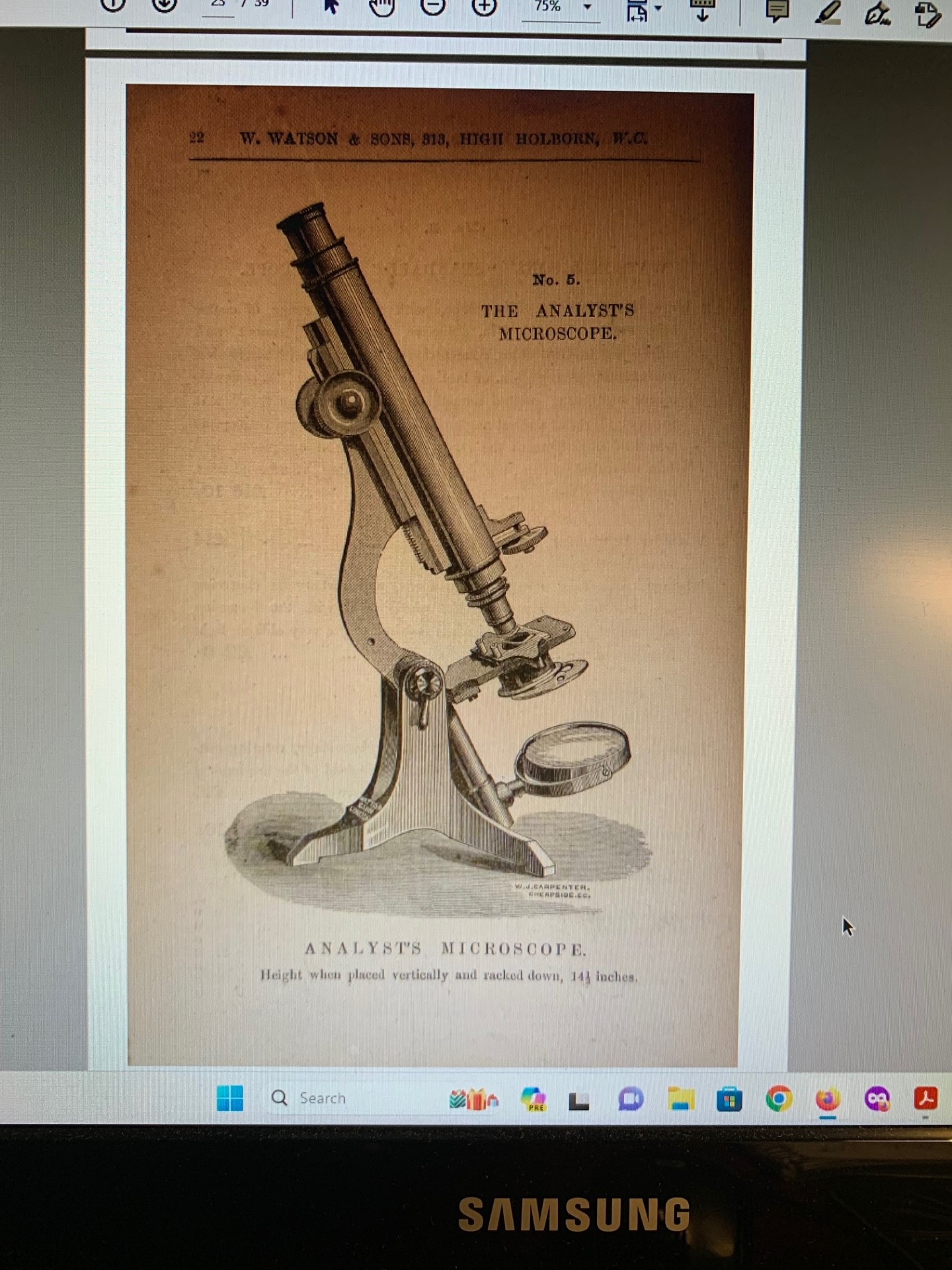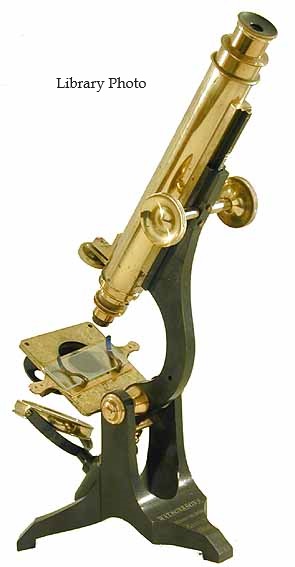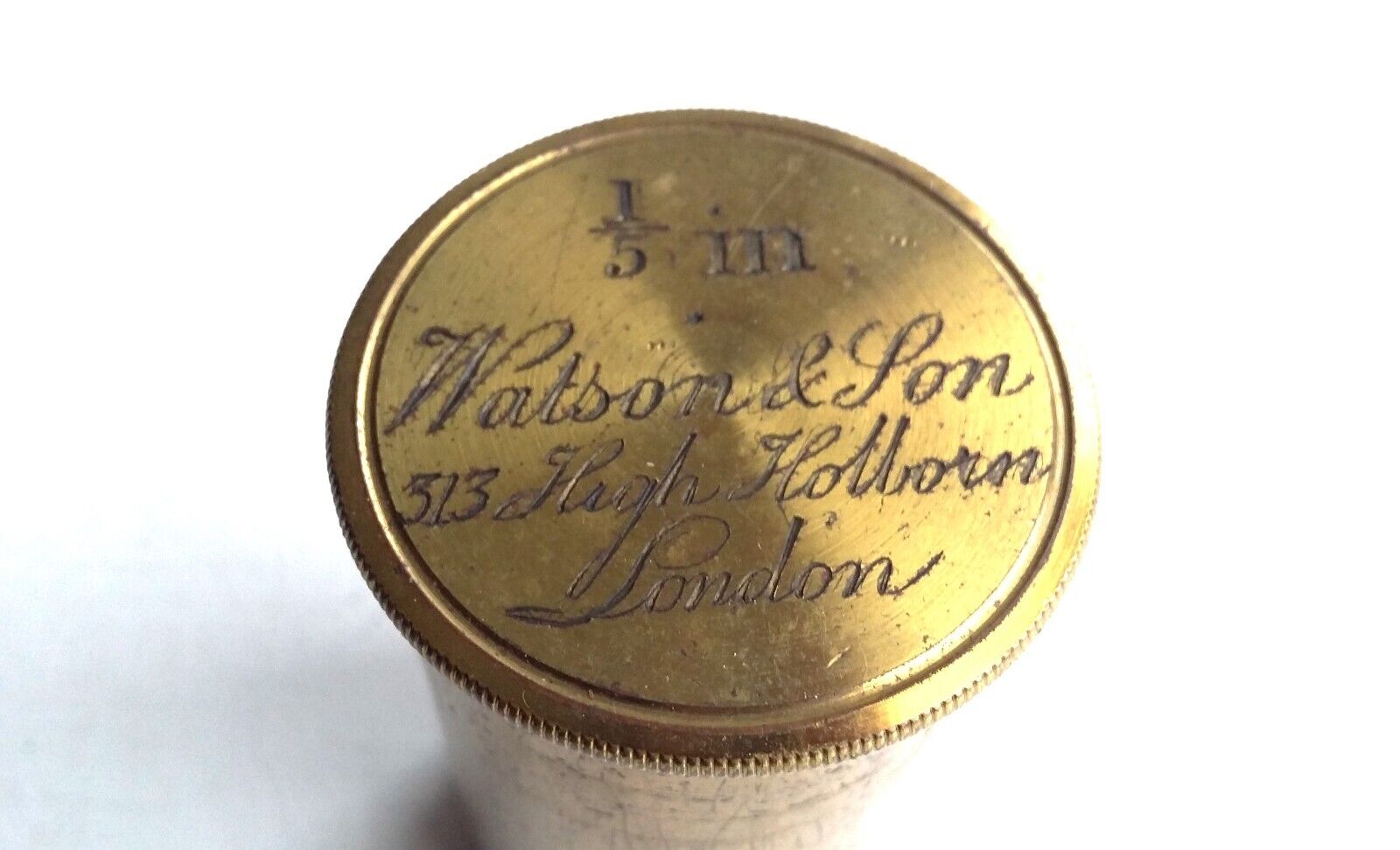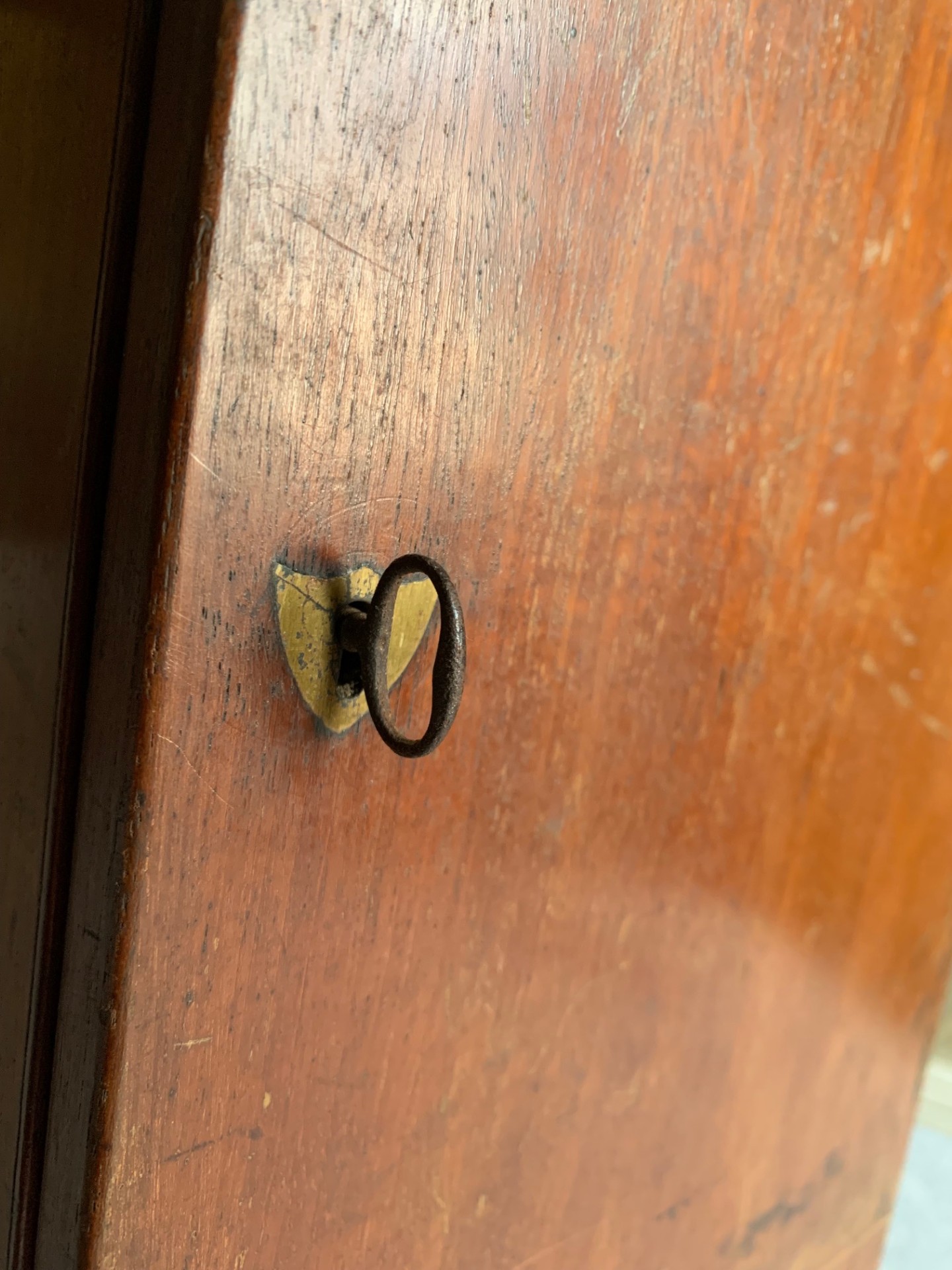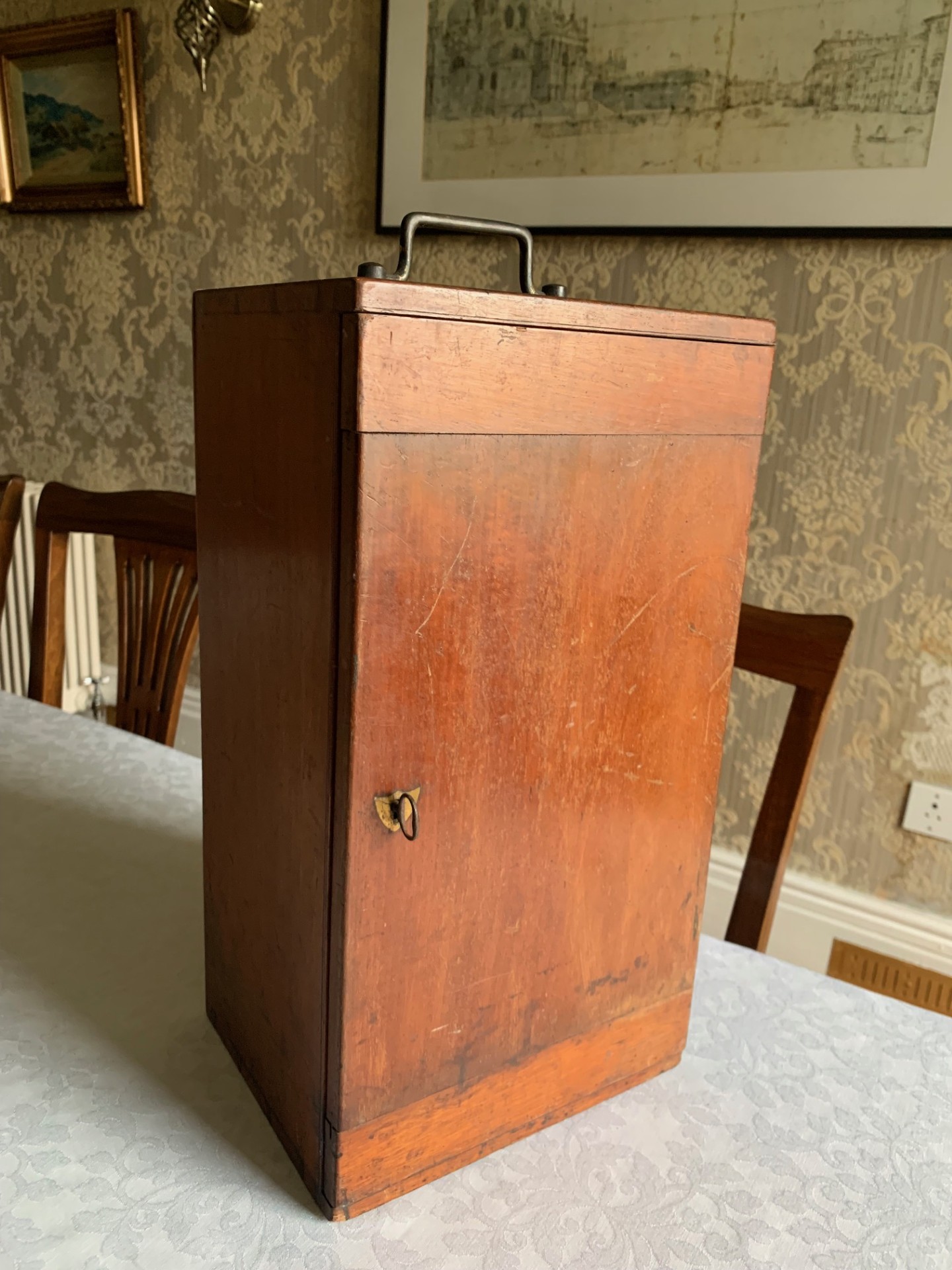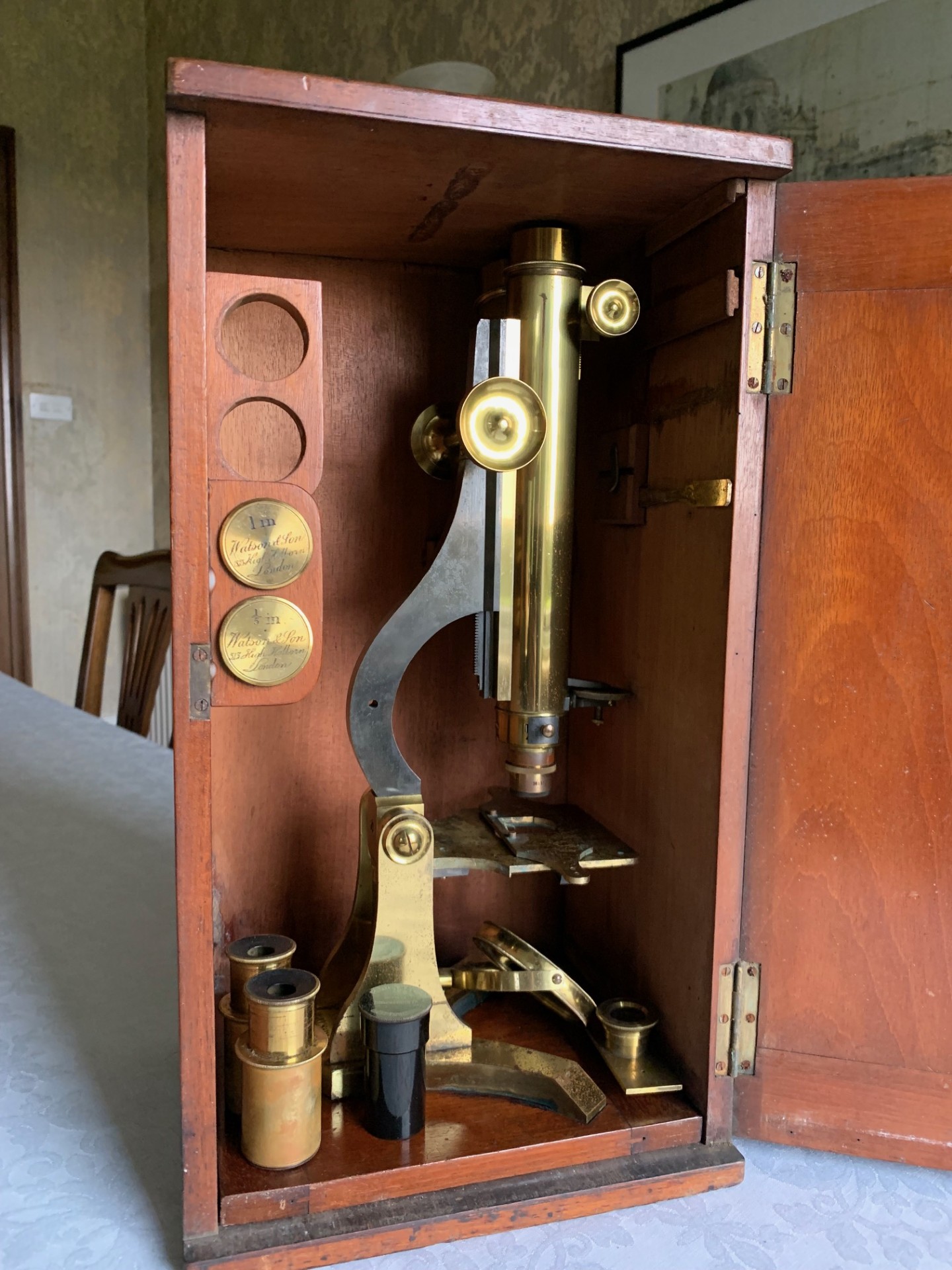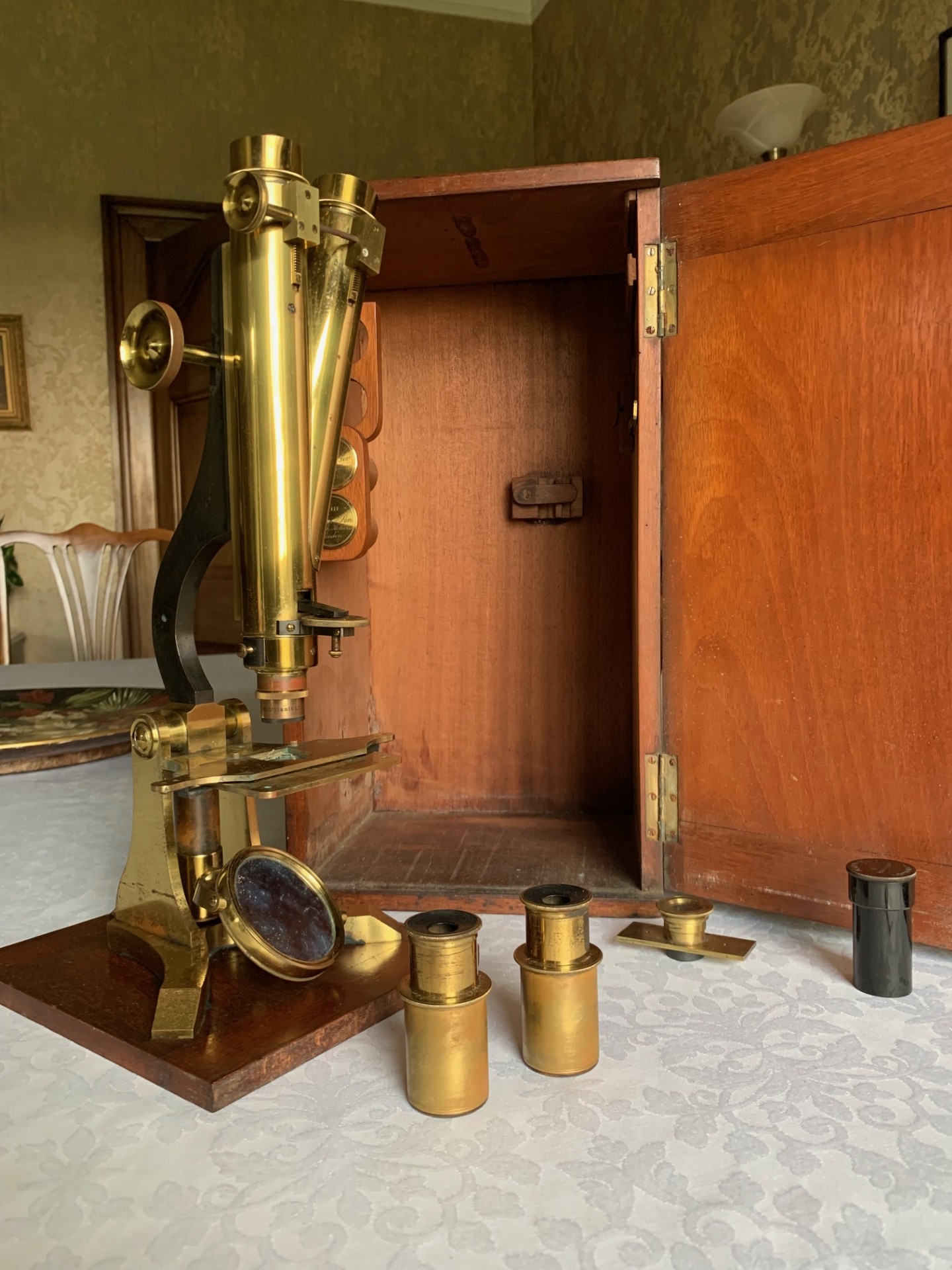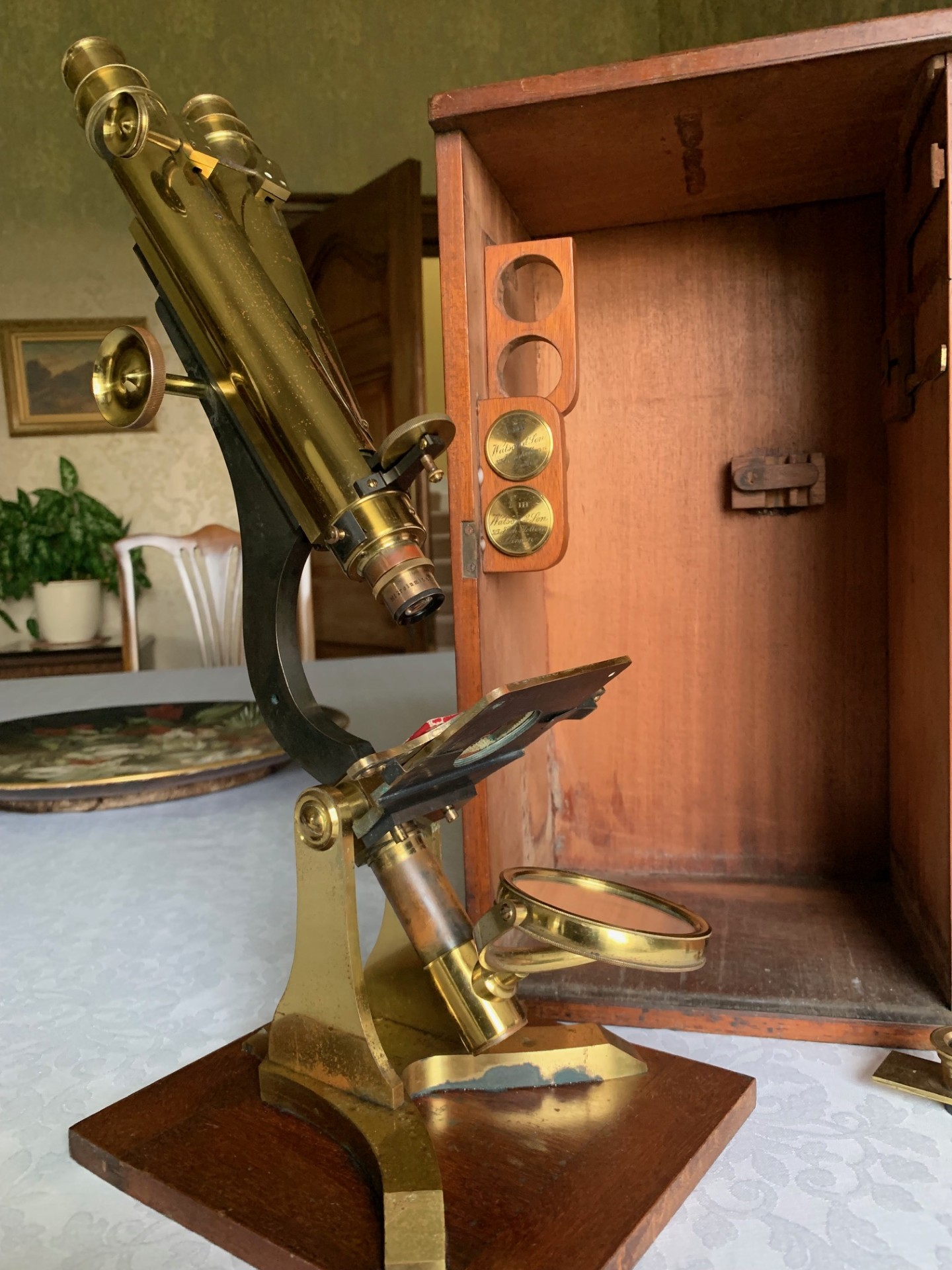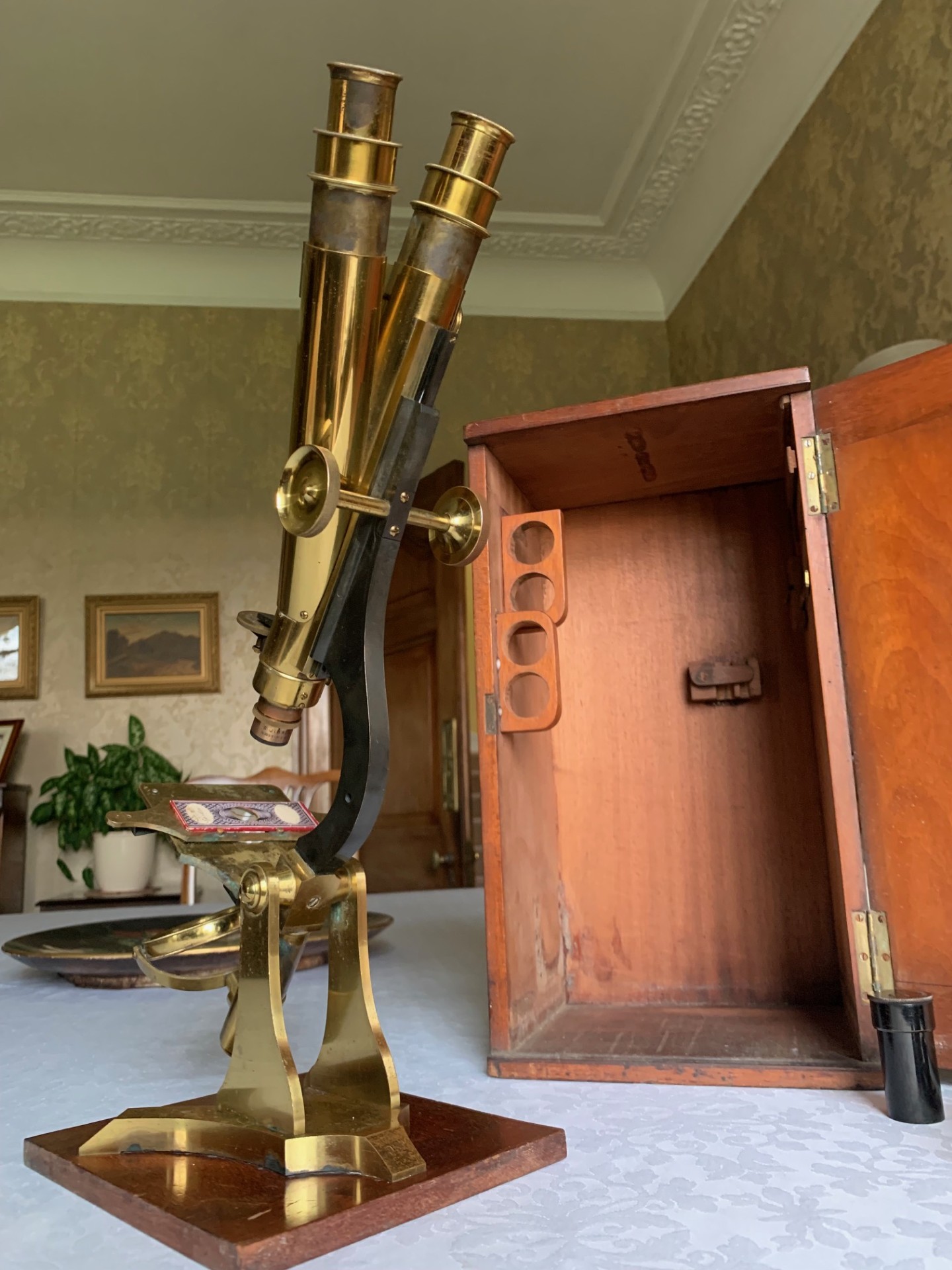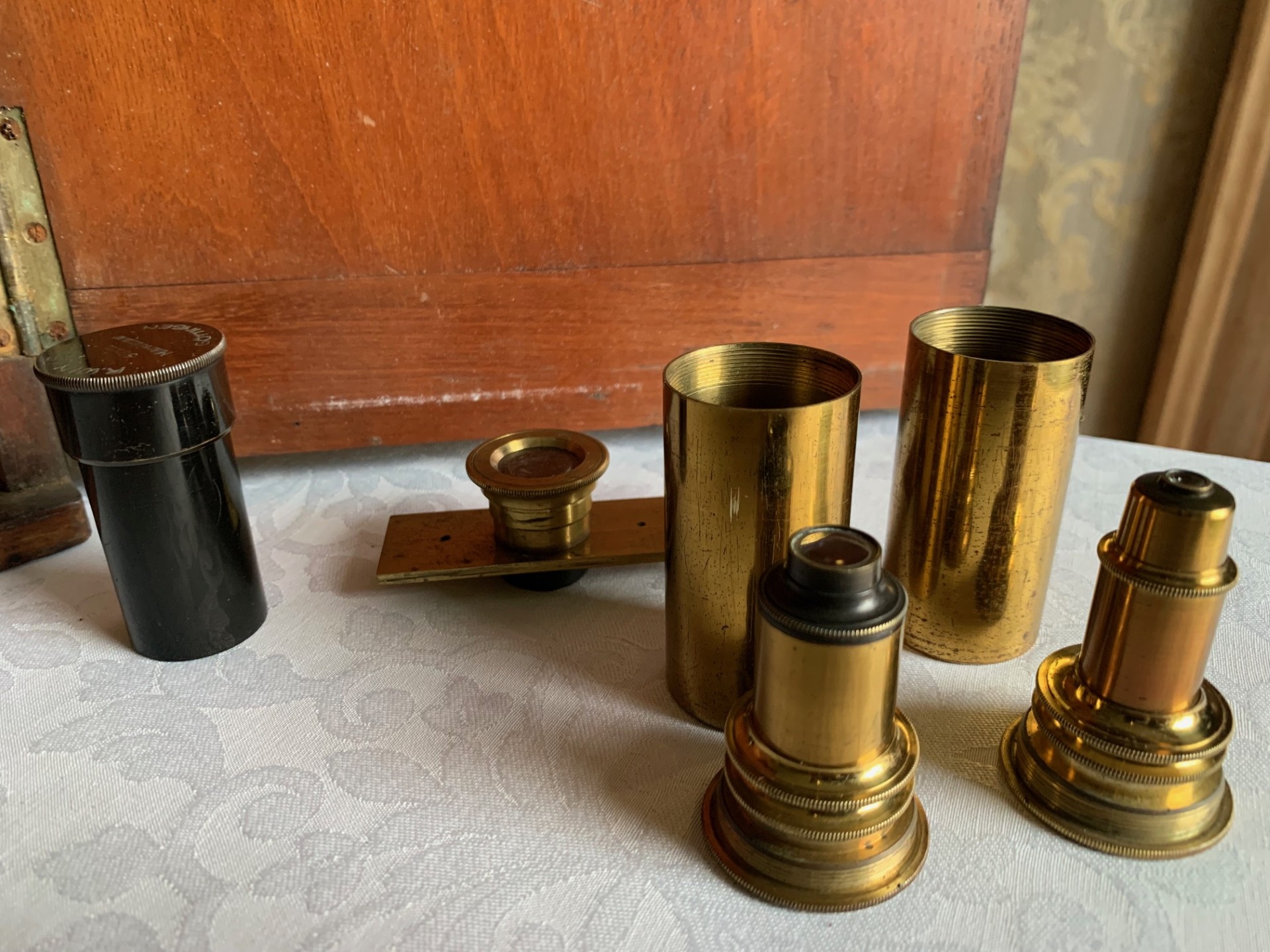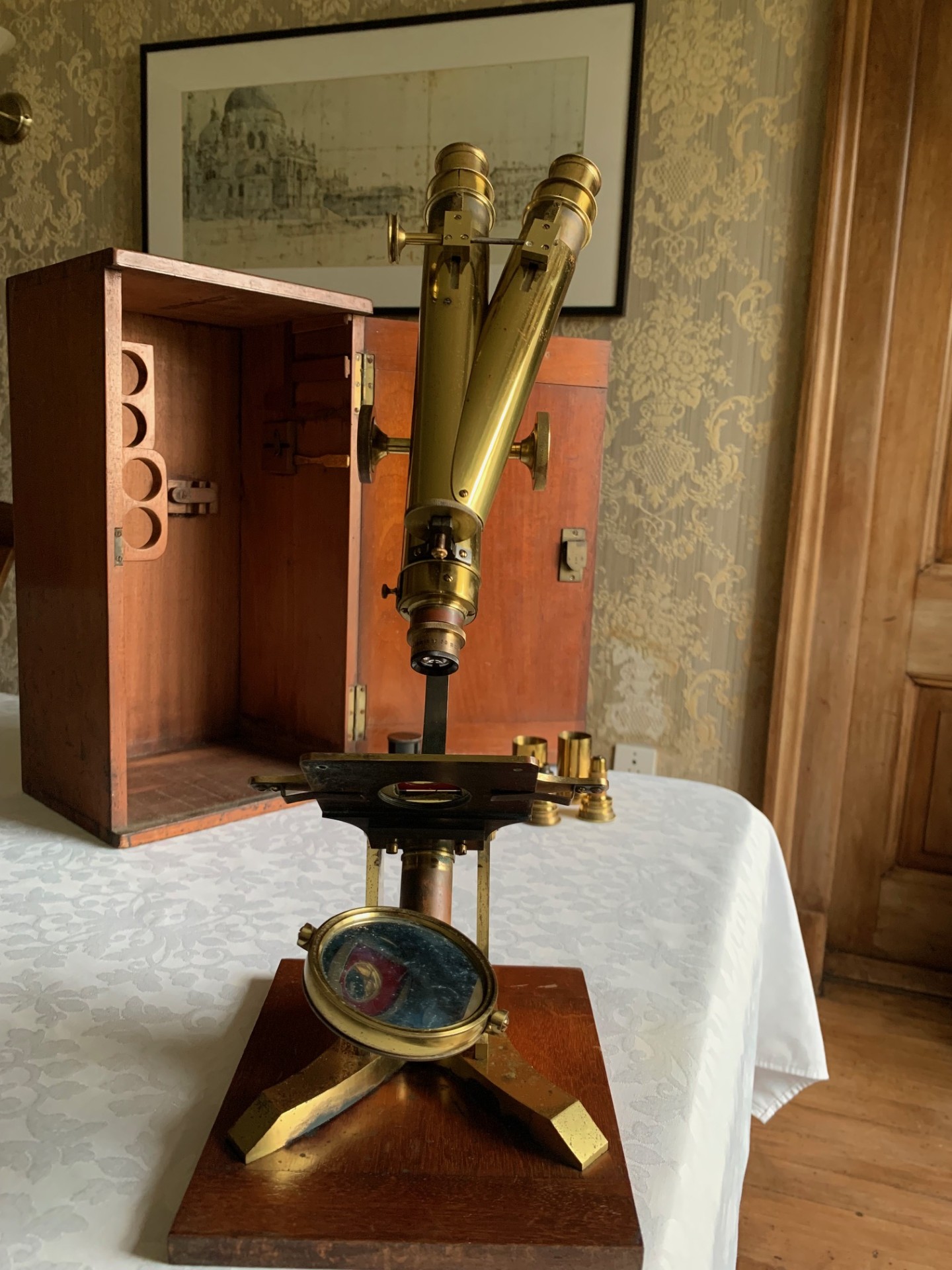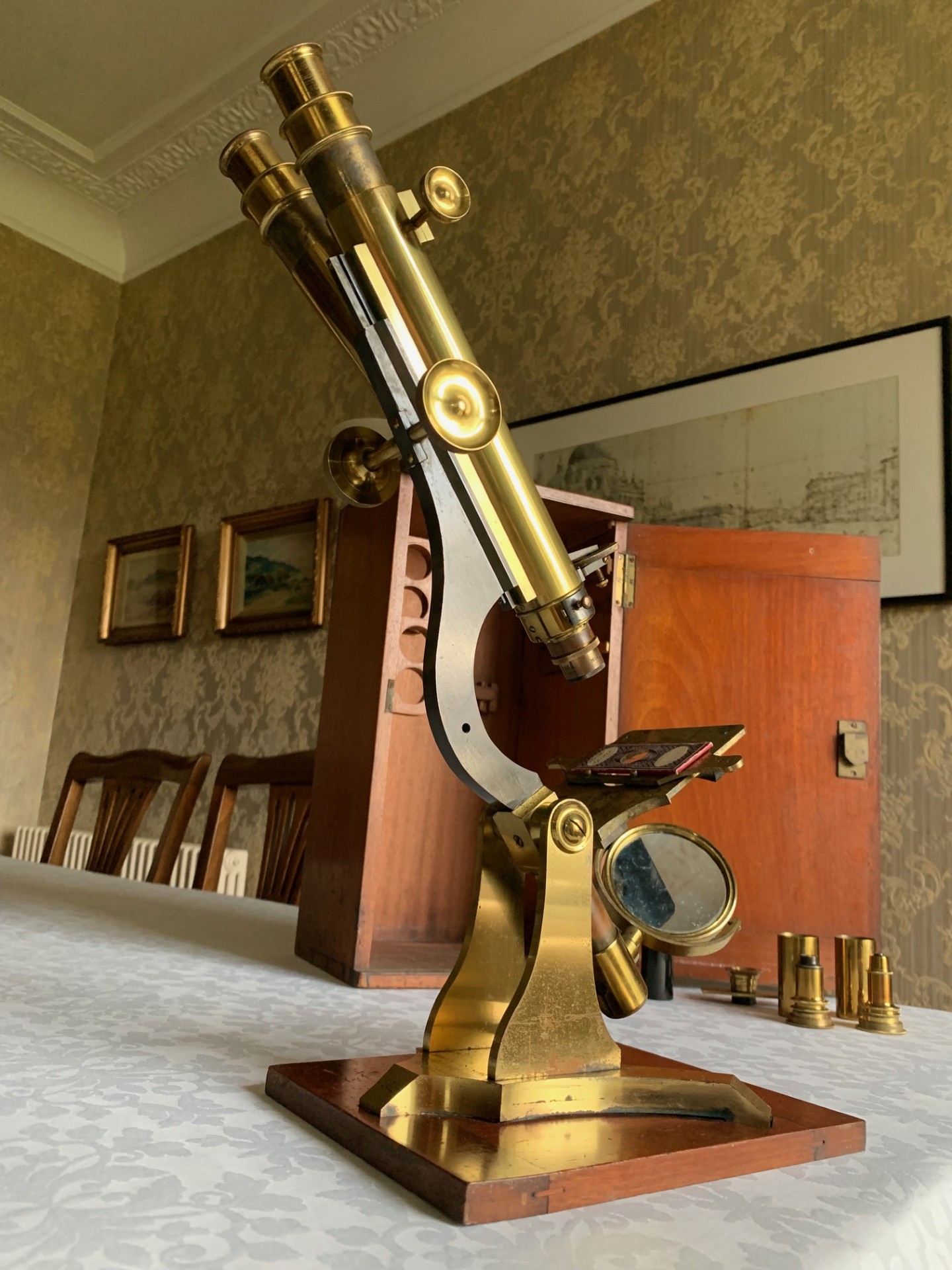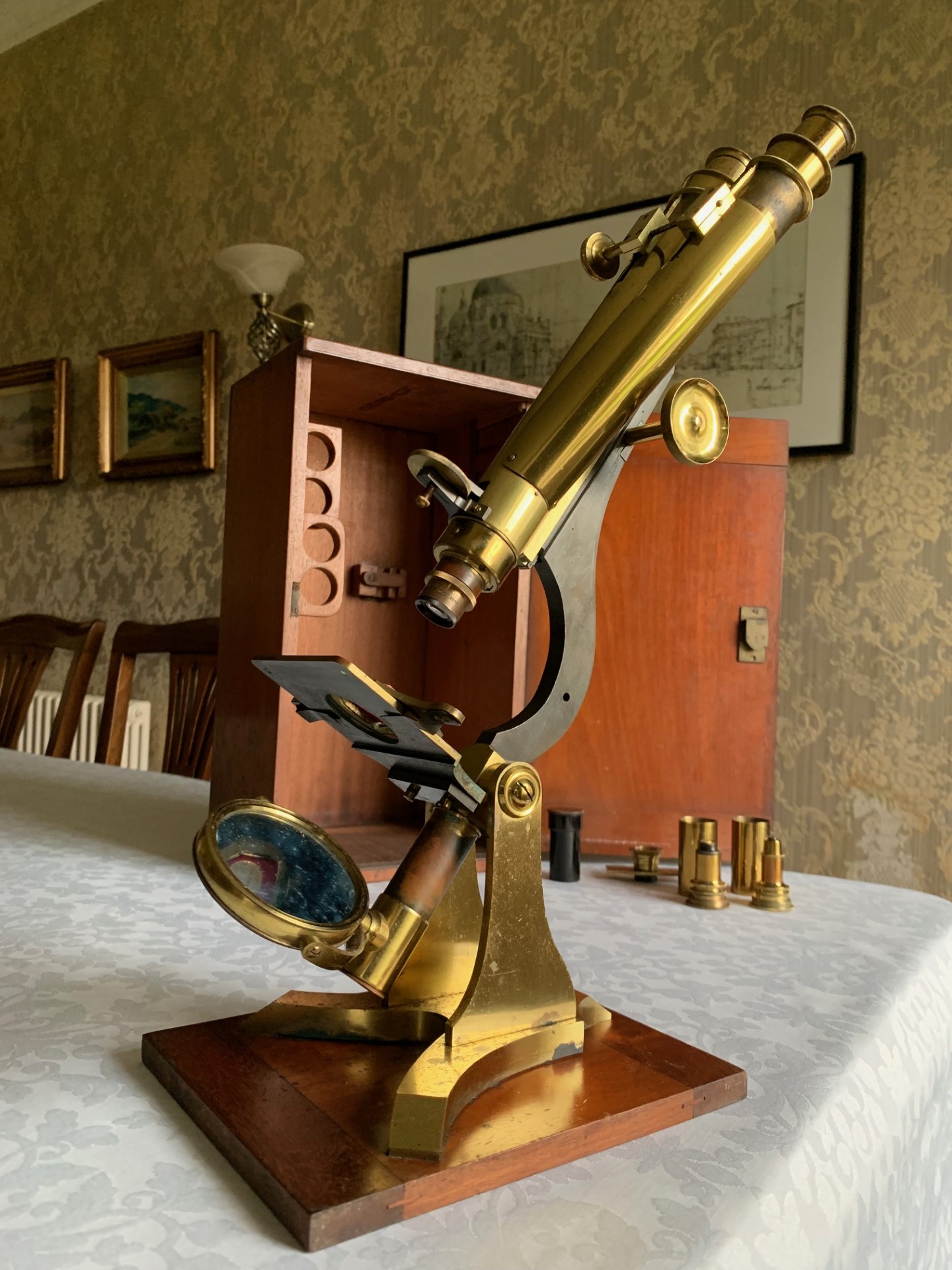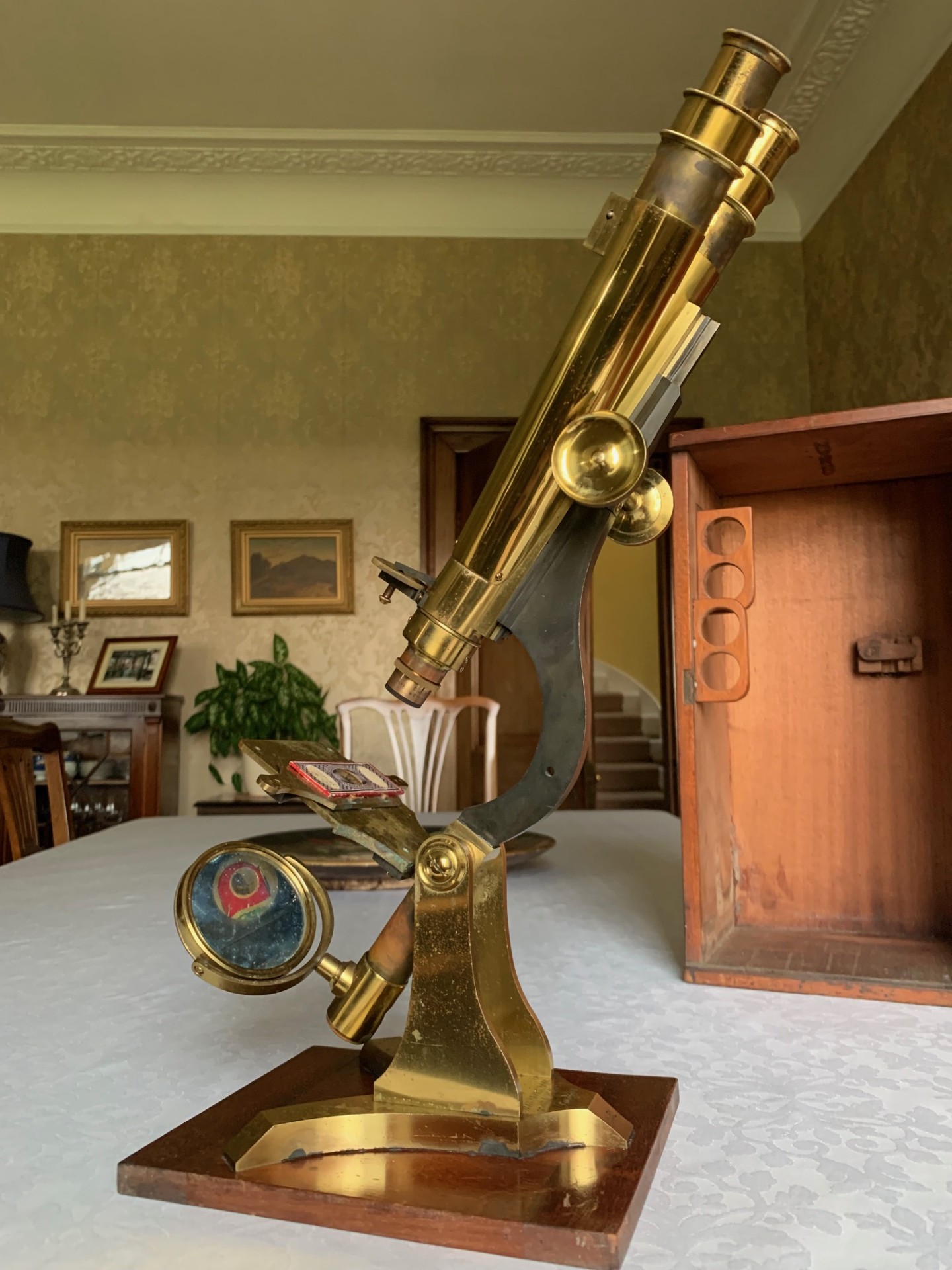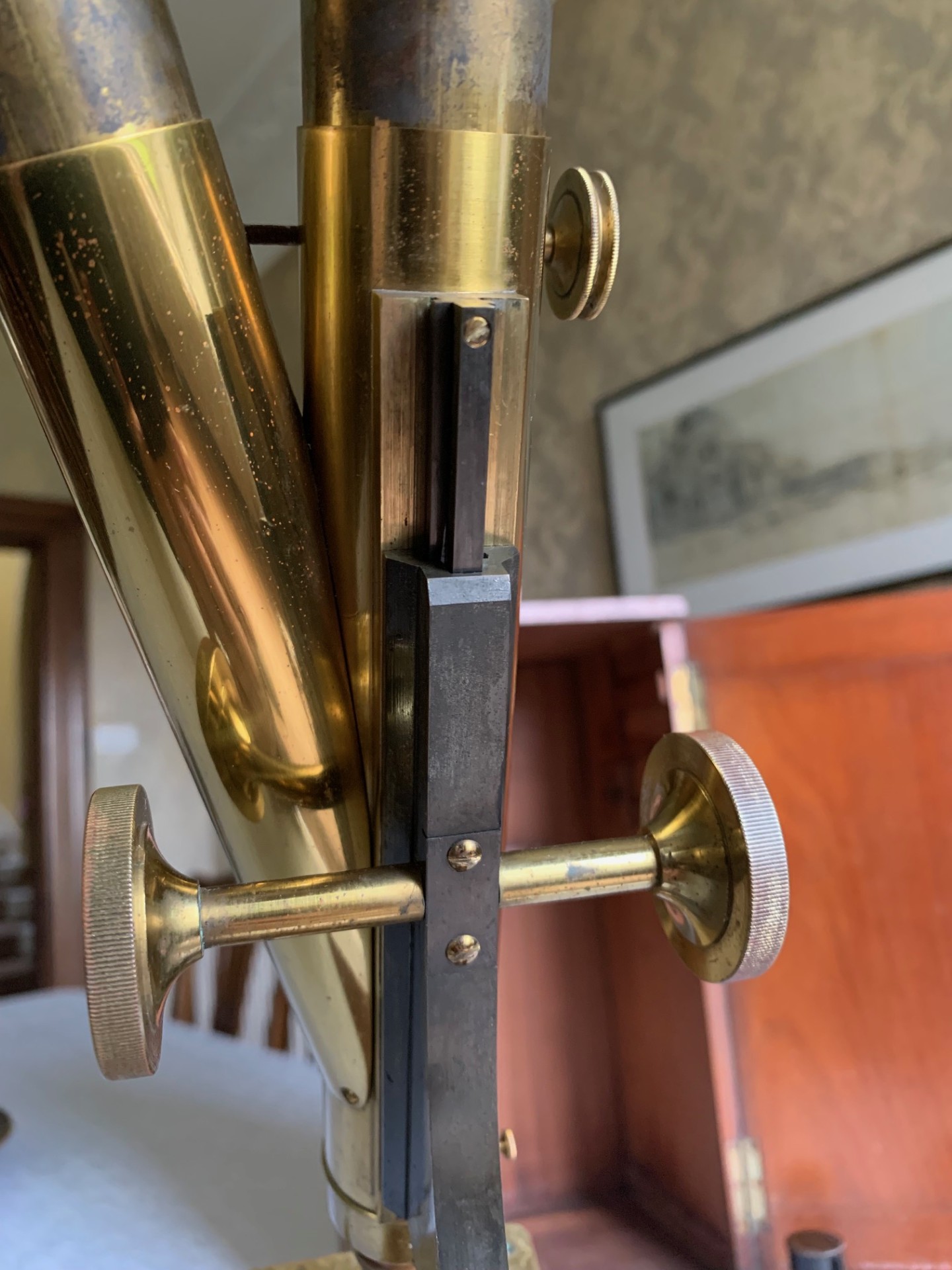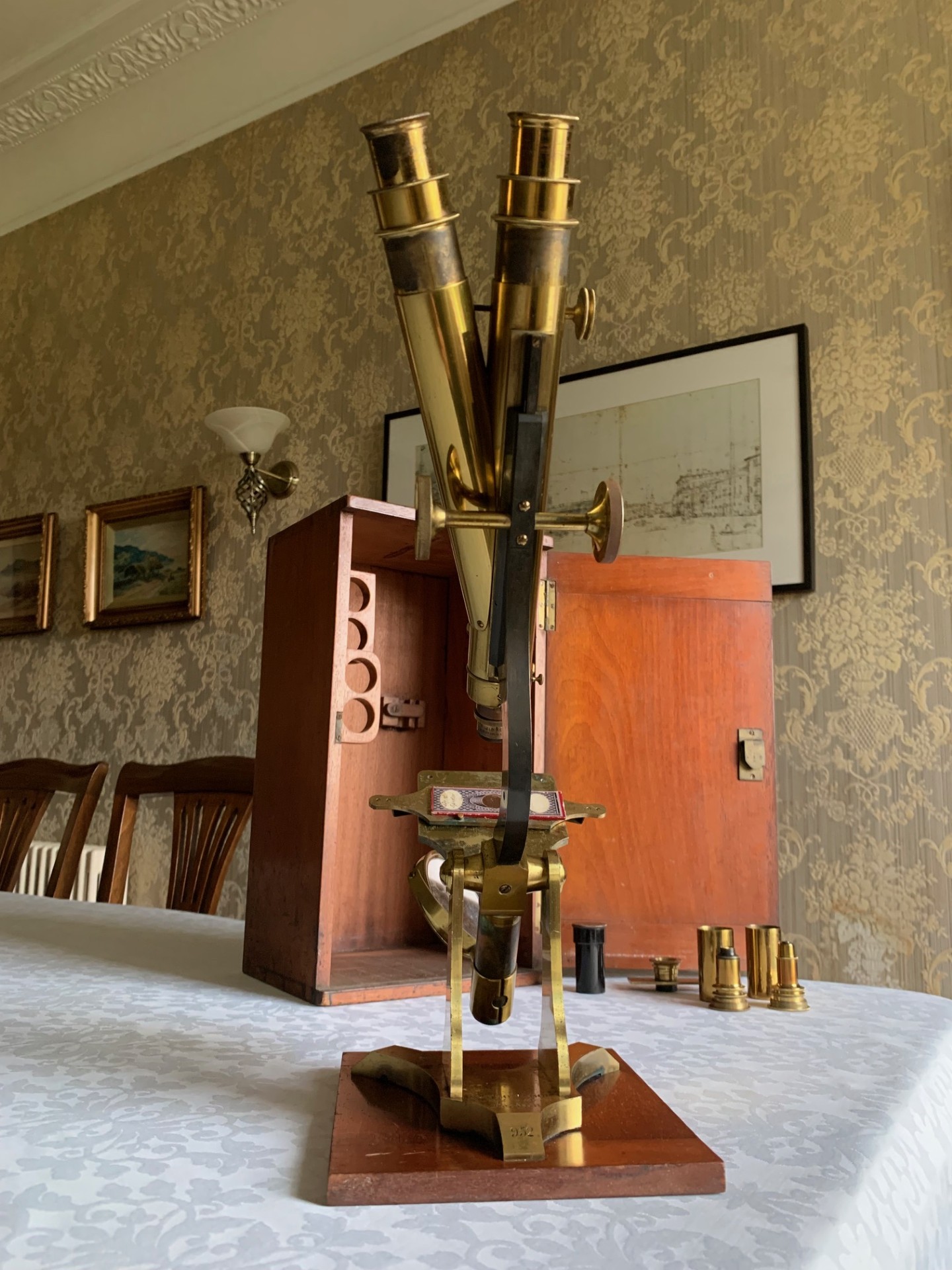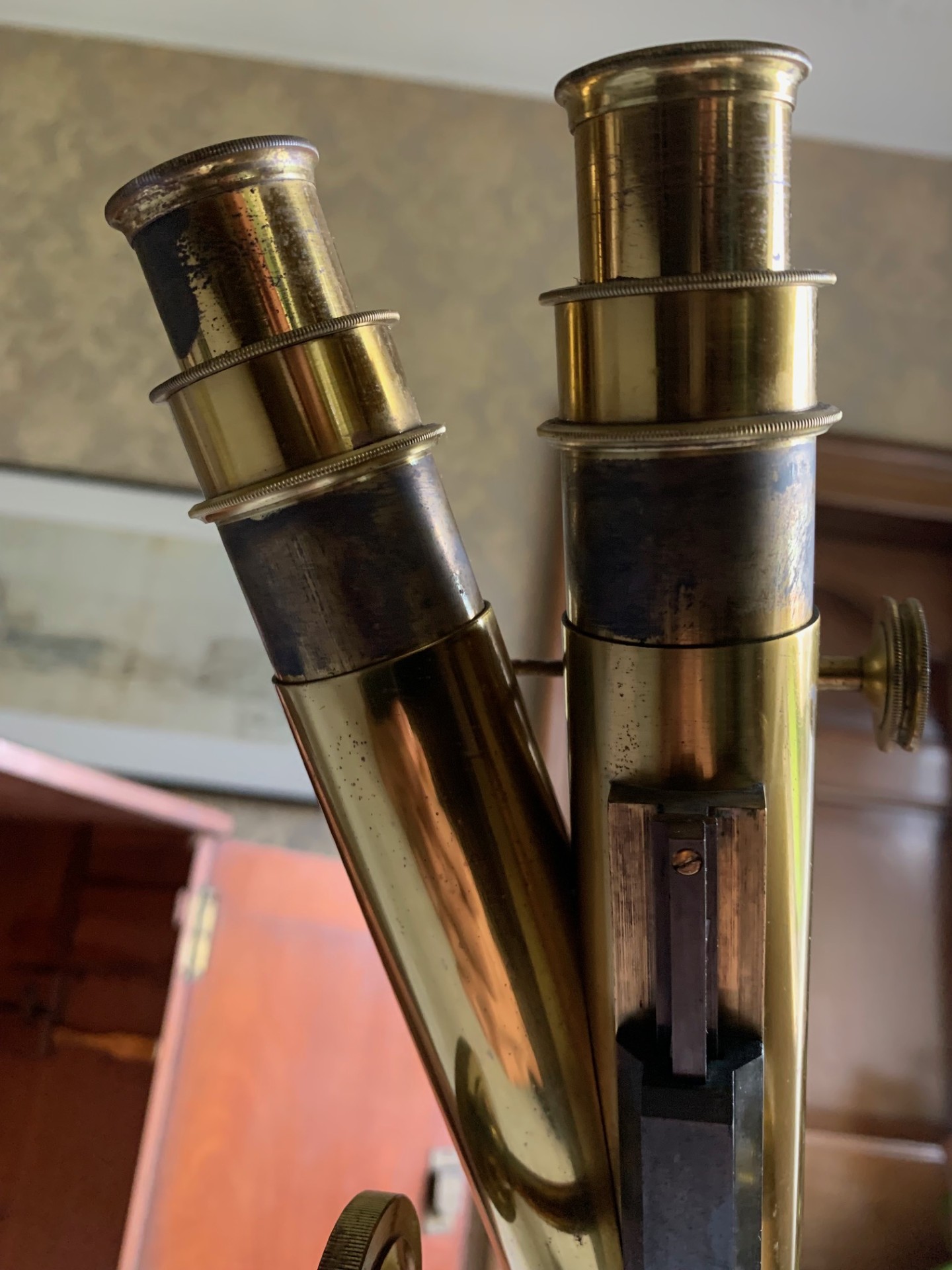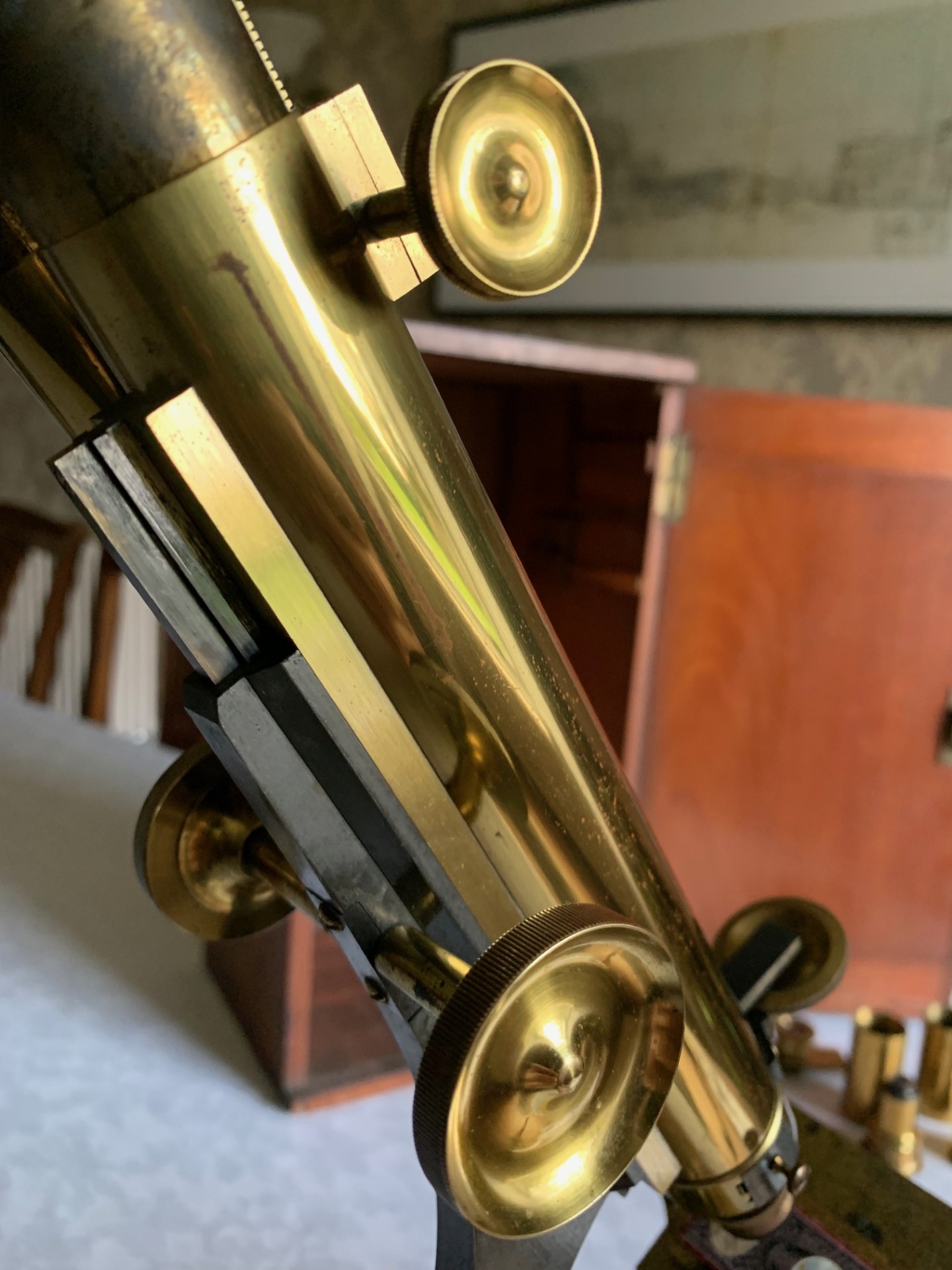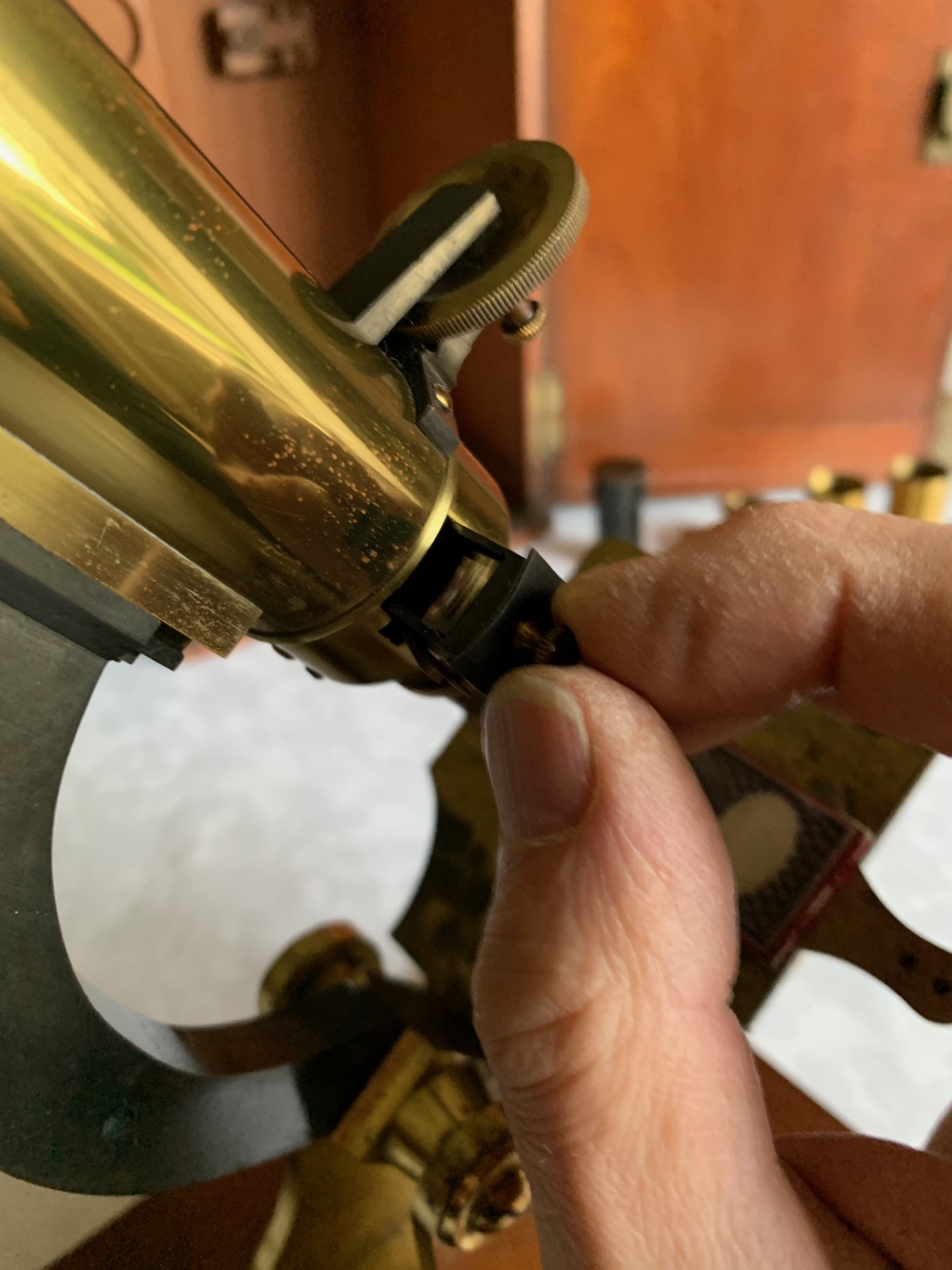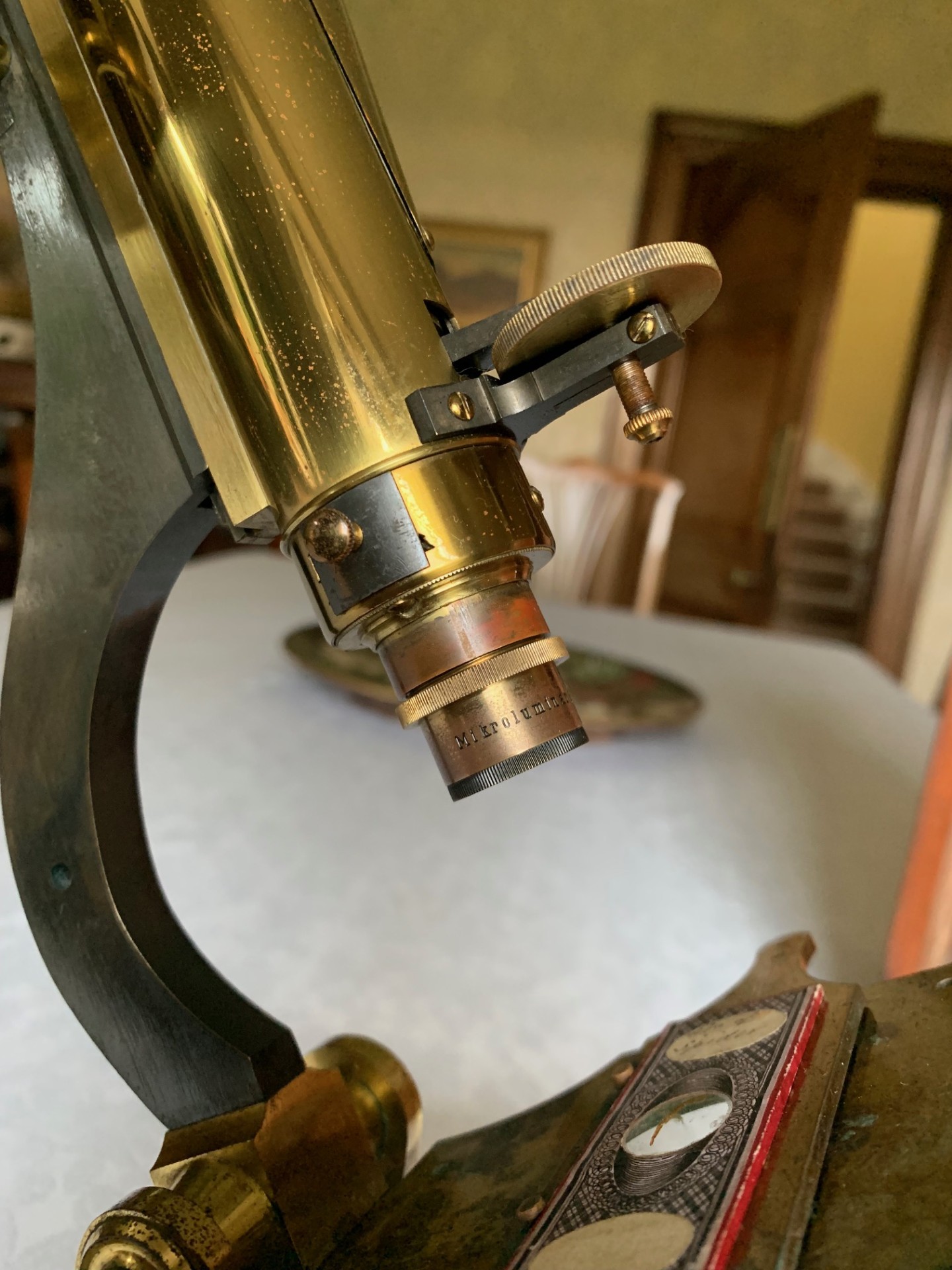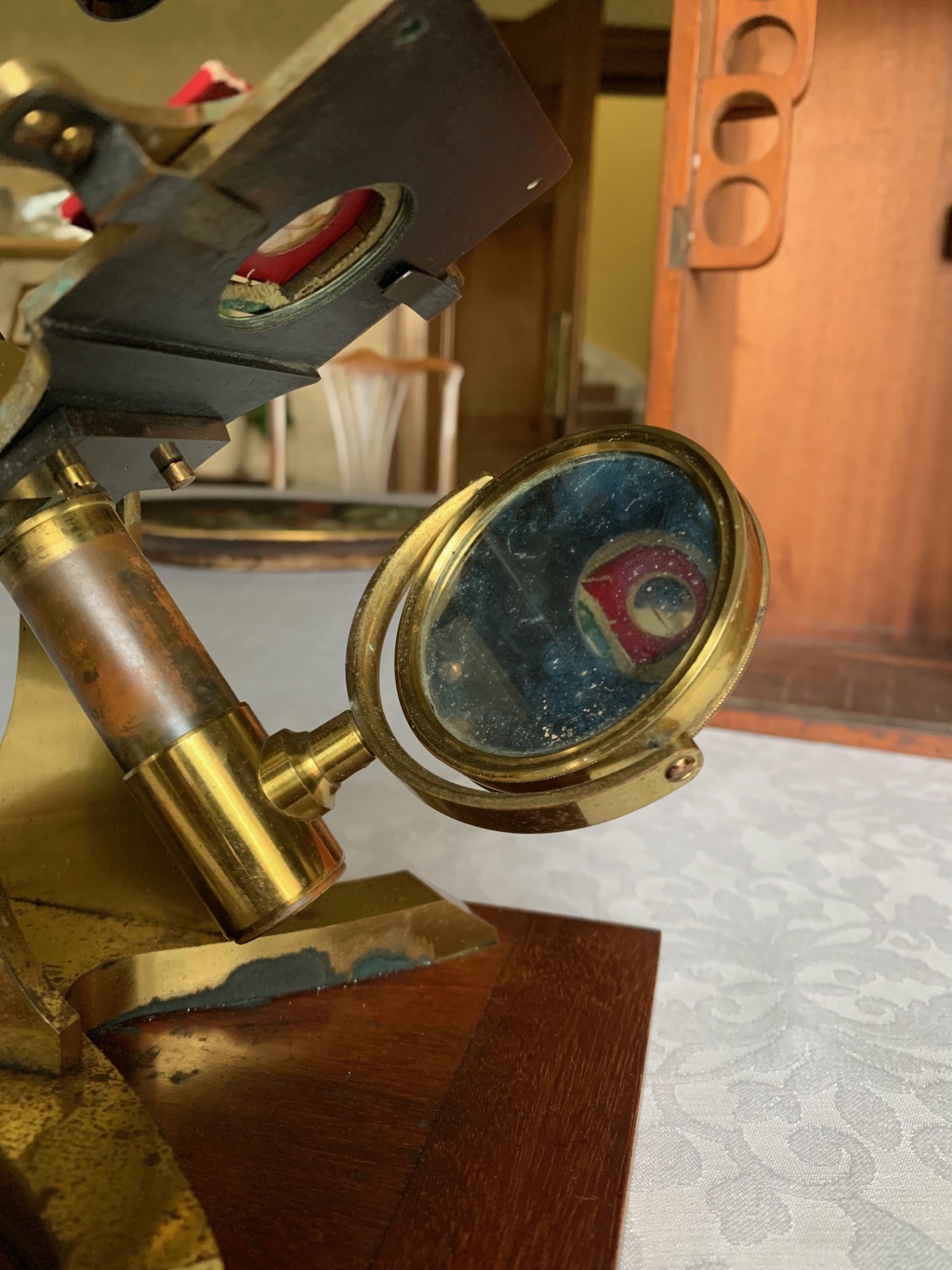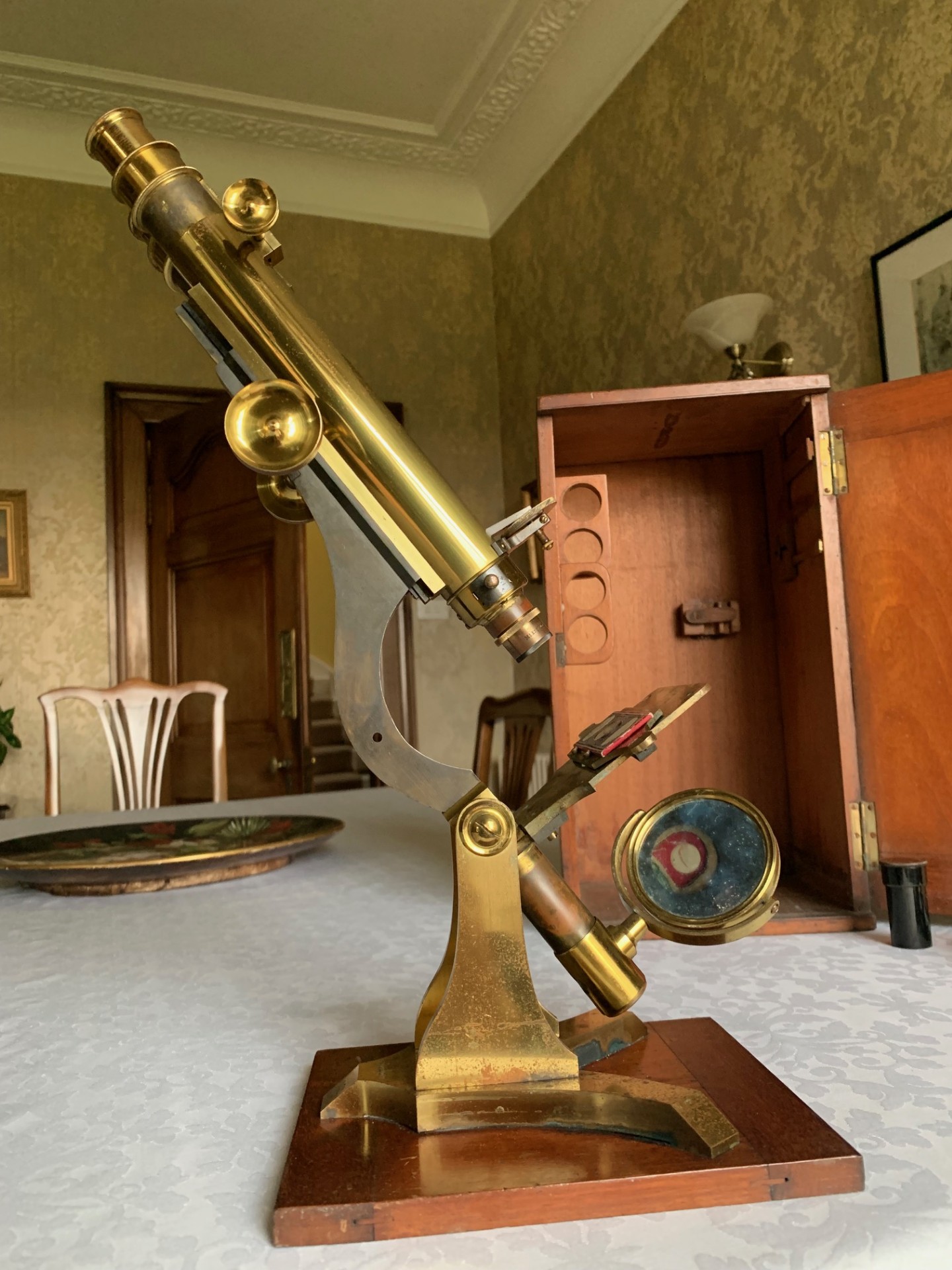SOLD – Antique Watson & Son – The Analyst’s Wenham Binocular Microscope – c1880, Cased
Sold
Antique example in rare Wenham binocular configuration of Watson's Jackson pattern brass model known as the Analyst's Microscope. The instrument is quite early dating to the late Victorian period - about 1880. This was before the second son joined the firm in 1882, so it's an early Watson & Son instrument. Definitely one for the Watson collector!
Circa
1880
Maker
W. Watson & Son
Country of manufacture
UK and Ireland
Description
Offered for sale is a very nice antique example of what appears to be an early example of Watson’s Jackson-pattern stand known as The Analyst’s microscope in anodised and lacquered brass – it dates to around 1880 based on its serial number 952, so it’s quite an early Watson pre-dating the introduction of Watson’s Edinburgh series of instruments. It’s marked Watson & Son with their address at 313 High Holborn and so dates to the period before the second Watson son joined the firm in 1882 and also significantly pre-dates the firm’s move to limited company status which occurred in 1908. This being an early example of a Watson and around 145 years old, as you’d expect it’s got some signs of use/wear and lacquered brass-work that’s also showing a little age-related spotting, tarnishing and lacquer losses here and there, but not that bad in reality, giving the instrument a lovely patina and time-worn look.
Watson’s description of this model in their 1884 product catalogue reads as follows:
“The Analyst’s Microscope
Large and extremely solid monocular microscope with rackwork coarse focus adjustment giving sufficient range for 4 inch objective, fine adjustment, universal sliding stage, diaphragm fitting under stage with wheel-of-stops, double mirror, plane and concave, with B eyepiece, 1/5th inch and 1 inch objectives………………….all for £7 15 shillings.”
There were also additional cost options for Wenham binocular like seen here with this example, mechanical stage and a high power 1/8th inch objective. The instrument was recommended as being suitable for the brewing trade. Watson also had available quite a long list of additional accessories all at extra cost.
For reference, there’s a photo copied from Watson’s 1884 catalogue and also another library photo of a Watson Analyst’s model in monocular configuration in the listing photo stream.
In terms of construction, the instrument has a polished Y-shaped foot in lacquered brass – this is a point of difference to standard Jackson-pattern models in Watson’s product range. Therefore, the foot may be a later replacement, or more likely just an early version with the style of foot carried over from other early examples of Watson production such as bar-limb models produced in this period, since Watson did only start manufacturing microscopes around the mid-1870s. Attached to the Y-shaped foot are twin uprights supporting a pivot with tension adjustment available. There’s an elegant long lister-type upper limb in anodised brass. This example is secured to a wooden base-plate giving additional stability in use, also allowing use on a polished surface if so desired.
Turning to the technical details, the coarse focus is via rack and pinion with the older style horizontal cut rack that’s in good condition with no damaged teeth. It has a reasonably smooth action that holds in position on adjustment. The coarse focus thumb-wheels are in brass, also showing very little spotting and tarnishing. Fine focus is of the older type and operated via a separate brass thumb-wheel located at the front of the main tube, which operates against sprung resistance acting on the nose-piece only and works quite well.
In term of its optics, this is a binocular instrument with double Wenham tubes and a small glass Wenham prism located just above the objective lens that splits the image. The prism is reasonably clean, with no chips visible and when correctly positioned gives a stunning image to both eyepieces with no collimation or significant brightness loss to the left hand optical tube. There’s a photo of the Wenham prism in the listing showing it before I’d given it a light clean. This Watson microscope comes with mechanically operated non-graduated brass eyepiece draw-tubes inside the Wenham tubes and there’s a pair of top-hat eyepieces of about 6x magnification.
There are two period Watson & Son objectives in their correct canisters as follows:
– 1 inch – approx 6x magnification
– 1/5 inch – approx 30x magnification
I’ve also been using a low-power brass 50mm objective lens by Reichert which I will also include – about 3x magnification.
Overall therefore, the range of magnification available with this Watson Analyst ranges from about 18x with the lowest power lens combination, up to around 180x with the highest power combination.
The specimen stage is in brass and is currently fitted with the Watson universal stage, which works well giving good range of x/y adjustment and it holds position well on adjustment and on inclination. Slides are placed on it and rest against a pair of retaining studs as shown.
There’s no technical sub-stage fitted to this example and lighting is via a plano-concave mirror in a brass mount that’s on a height and swing-adjustable brass support arm with slider and gimbal, with period silvering that’s in decent condition to both sides with some margin losses but good reflectivity.
The instrument’s controls and friction surfaces have been very lightly lubricated and operate smoothly with a nice feel and surprisingly for an instrument of this age there’s only light age-related signs of wear to the various moving parts. This instrument presents pretty well with lacquered brass-work that catches the light really well as I hope the listing photos demonstrate. This example is essentially a usable early antique Watson with the statement feature of double Wenham tubes, making it a fantastic display proposition and it’s offered at an attractive price point for an antique Watson model of this age, specification and condition.
There’s the original Watson storage case with this example as shown in the listing photos. It’s got a good exterior finish that looks right for the period, original brass carry handle, working lock and key which is always nice to have (it even looks like the original key) and various internal lens racks.
Accessories – live box in brass.
Owing to the weight and delicacy of this antique Watson microscope, it will be partially dismantled, very well wrapped for shipping and dispatched by insured courier upon receipt of cleared funds. Overseas buyers please use the eBay Global Shipping option if available for your territory, or contact seller for alternative shipping options and costs.
Thanks for looking.
Ask the Dealer
Dealer information
 Arcboutant Scientific
Arcboutant Scientific
Howard Nutton based in Glasgow Scotland with a background in Natural Science along with previous career in risk management. I obtained my first antique microscope in 1988 - it was a Watson Edinburgh model H serial number 23604 - dating it to 1918. Since that time I've owned and restored hundreds of similar instruments. As Arcboutant Scientific now also making available personally curated fine examples, principally of antique microscopes and associated scientific equipment by quality English and Continental makers, to collectors world-wide.




